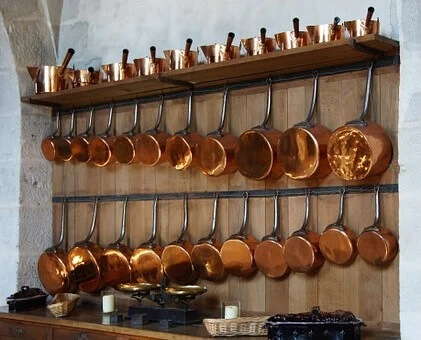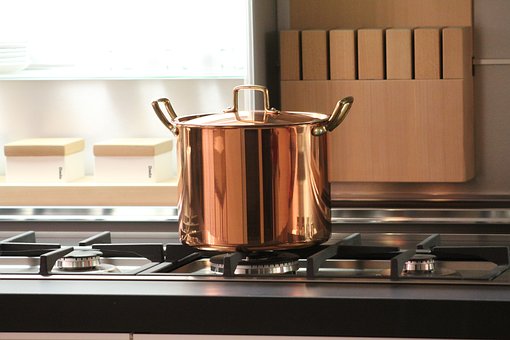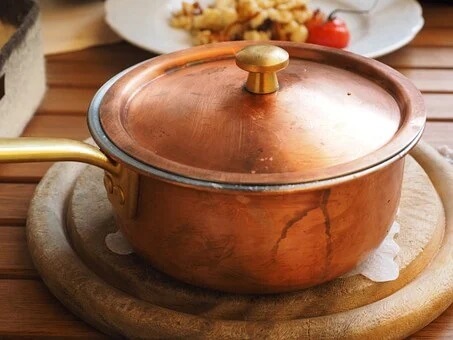This page contains affiliate links and I earn a commission if you make a purchase through one of the links, at no cost to you. As an amazon associate, I earn from qualifying purchases.
Chefs, cooks, and bakers can’t be wrong. Copper pots and pans are fantastic.

This is an age-old debate that is never going to resolve. Humans love what they love and are staunch in their steadfastness, and as such, we differ greatly, thankfully, or it would be one big boring planet. We all know people who swear by gas, electric, or wood-fired and there is nothing to be done to change their minds, well, copper-obsessives are no different.
I for one, am one. Totally obsessed.
One hears all these petty squabbles around dinner tables and pubs which are akin to predicting yesterday’s weather. Completely moot. You are, or you’re not.
If you don’t like copper or never even thought of trying a pan I will try to convince you, after all, that is what I am writing this for. And, if you are a fellow copper aficionado, stay with me as I discuss how to get more out of your copper cookware.
What works in copper, and what doesn’t?
Why would anyone choose to prepare food in a metal that is so archaic it dates back 9,000 years? I can tell you for sure, and it has nothing to do with having something stylish standing on your cooker or stovetop.
Cast iron, aluminum, steel, and stainless steel are more modern and ‘advanced’ – as are fancy coatings and bases. As are fancy coatings. But nine millennia, nobody has found cookware that has such uniformity.
Cooking in copper pots and copper pans means that the one thing you count on is uniformity. Copper is unbeatable when it comes to heat-conducting metals for cooking. Copper warms quickly and cools slowly, efficiently distributing the heat. Uniformity of heat distribution ensures that with well-made copper, you will never see burn spots or scalding on your cookware.
Copper ensures quicker, metered control over your cooking as you are able to attain precise heat levels. This is the first reason Professional chefs who use copper, say they do: Because of the superiority and versatility of heat conductivity.
I’ve tried them all. From cast iron to carbon steel, numerous non-stick alternatives. and stainless steel, but I always go back to copper.
Copper can be scary at first
First-time users often find copper hard to connect with, I’ve seen it frequently with friends and family who may be helping me to prepare a meal in my own kitchen. They pick up the copper pot or pan and are always surprised that they are a lot lighter than they look.

Then they’ll look at the receptacle every which way and aren’t quite sure what to do with it. Everything about it can be a bit tricky to grasp. So here is what I always advise: “Be ready to adjust recipes when using copper. Its conducting quality means both heat and cooking time may reduce by as much as half!”
I am often asked these two questions. Who in their right mind would pay so much more for each piece and go through the time to learn to use copper cookware? Why use non-dishwasher-safe cookware which requires regular care and polishing the bases with copper paste?
Those of us who are passionate cooks enjoy the precision they get from their copper cookware. Just imagine a gorgeous Sunday roast with all the trimmings sitting in a big gleaming rectangle roasting pan on your dining table. Magnificent.
Copper has some other endearing qualities too. One is that it is by default an anti-microbial metal. That doesn’t help with your cooking, as your food never actually comes into contact with the copper per se. This is because copper cookware is lined with another metal, mostly tin, on the inside.
Who can doubt the visually compelling appearance of copper pots and copper pans? The somewhat Daliesque reflections from their polished surfaces?
One sees so many kitchen shoots for magazines that display copper cookware because of the richness and, often, variance in the color.

Copper is also an ideal weight for cookware – sitting firmly on burners and other surfaces, but light enough to lift with one hand.
In the end, switching to copper is an individual or family decision. Think about it carefully, the price, the versatility, the extra care needed in cleaning them. Take everything into account. And then go and get your first piece. You’ll either love it or hate it. However, if their price far out seeds your bank account, not to worry as you can always find a second-hand, if not a little battered gem at a weekend or flea markets.
But most importantly, just have fun with your cooking, even though copper pots don’t rule the world…yet.

